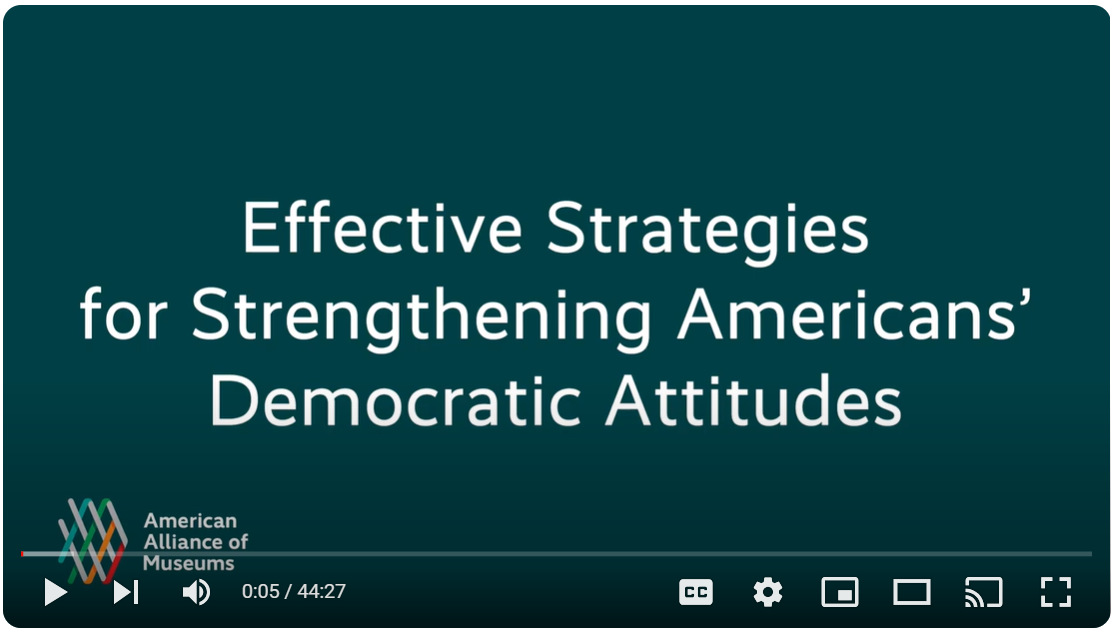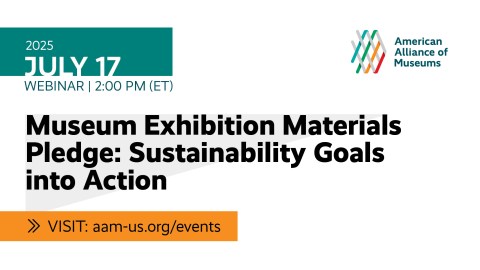
American democracy is under a significant threat from a concerning number of partisans who tolerate anti-democratic practices endorsed by political elites and/or harboring strong hostility towards members of opposing parties. The Strengthening Democracy Challenge (SDC), a large-scale scientific study, reveals underlying causes and solutions to counteract these problems. Panelists will share successful strategies to mitigate anti-democratic attitudes and political animosity and the potential role for museums in fostering civic cohesion.
Speaker(s):
Moderators:
- Jan G. Voelkel, Doctoral Candidate, Stanford University, Polarization and Social Change Lab
- Joe Mernyk, Doctoral Candidate, Stanford University, Polarization and Social Change Lab
Panelists:
- Katherine Clayton, PhD Candidate, Department of Political Science, Stanford University
- Luiza Santos, PhD Candidate, Department of Political Science, Stanford University
Transcript
Jan Voelkel: All right, I think we might get started in three minutes and give it a bit more time for people to trickle in.
I’m seeing that people are starting to use the chat. That’s great. We are having lots of different ‑‑ people from different locations, very excited to see that. Yeah.
So before we get started, let me say a few brief words about what who we are and what we’ll talk about. We are a series of graduate students at Stanford University, and we are going to present on the scientific work we have been doing on identifying and testing. All of these different interventions are related to a joint project called the strengthening Democracy challenge. I’m going to give an overview of that project and then afterwards we will dive into three of the most promising strategies from that project, which will be presented by Joe Mernyk, Katherine Clayton and Luiza Santos. Very excited about the ‑‑ about these different presentations, and I’m going to get started with the first presentation now.
Can y’all see the slide show?
Okay. All right. Perfect. I’ll give an overview of the strengthening of Democracy challenge. This is a large scientific experiment that we have done trying to test interventions to reduce Americans antidemocratic attitudes. This is based on public polling data that suggest that lots of Americans are not happy about the current state of American politics.
So like 81 percent of Americans say that they are concerned about the divisions between Republicans and Democrats, and 64 percent are saying that American Democracy is in crisis and at risk of failing.
And like ‑‑ what we are going to focus on today is effective psychological strategies for reducing one partisan animosity and two for reducing support for undemocratic candidates.
What does that mean? Well, when we speak about partisan animosity, the tendency of people identifying as Republicans or Democrats to view opposing partisans negatively.
If you would like to have something that is more direct and like ‑‑ if you can think of something that is measurable, you may think of this question of like how do you feel to what the Republicans or Democrats, this is the most common measure that is used on the scale from very cold or very warm or favorable feeling.
Using that research over the last two decades has shown that Americans have disliked the supporters of the other political side more and more, like especially since the year 2000.
So this is the trajectory of the figure while at the same time, partisan homophily. Liking of supporters of the same side has remained pretty steady over that same time. We can describe this time period really as the rise of partisan animosity. Sometimes partisan animosity is put together with support for undemocratic candidates.
We are also pursuing this from a partisan angle, specifically we understand support for undemocratic candidates. The extent of which party politicians engage in undemocratic practices. The idea here is that while Americans in general find that key democratic principles such as rights and freedoms of all people or the ‑‑ independent of judges and political parties, they sometimes tolerate when politically elite violate these democratic principles.
So the strengthening Democracy challenge starts with these two problems and was an attempt to try to intervene on this on a very large scale. Like specifically what we did, we put out an open call for all kinds of interventions people could submit. What do I mean by the term intervention, well, think of an intervention as a set of instructions designed to modify people’s thoughts, feelings or behaviors. In this project specifically, we focus on interventions that can be employed online, that are relatively short, no longer than 8 minutes that do not have any financial incentives that are ethical in the sense you cannot use deception or misinformation, and that are substantively it Cal across all participants.
What did we do for this project. We tried to recruit ideas from a wide variety of people involving academics from across the social sciences as well as practitioners, there are lots and lots of people out there who work in so‑called organizations who have accumulated very useful knowledge on the ground that is typically not integrated in academic studies, and we ‑‑ like engaged in a lot of different methods, trying to recruit ideas from practitioners in our study and to be able to test them rigorously. How did we do that? We sent a lot of e‑mails, put out a call on Twitter. We tried to explain our approach in a lot of detail we held workshops to design the participation for practitioners who do not have as much experience with our experimental approach. We had cash prizes. So people who submitted effective interventions could win up to $45,000 and finally, we had a lot of one on one meetings where you put the most charming member of our team on a lot of conversations with especially practitioners. I still have regret I was not chosen as the most charming member of our team who you can see here on this picture here.
In part, due to the charmingness of our team member, we ended up with more than 250 submissions from across the social sciences as well as more than 50 submissions from practitioners, in total 419 people participated in our call for submissions from 17 different countries.
So now we had a new problem, we only had funding to test 25 different strategies. So we used advisory board of experts from across the social sciences and practitioners to identify what we deemed to be the most promising interventions. We selected 25 of these interventions and while ‑‑ I’ll give you an overview of the project, the remaining three talks will be in depth insights into what some of these most promising interventions are the second part, we conducted a mega study, what does that mean, basically recruited lots and lots of participants, more than 30,000, all of them were American part sans, so Republicans or Democrats.
And then we used a so‑called experimental approach, we randomly assigned these participants to one of 25 different interventions or control condition, you can think of the control condition, basically providing a baseline of partisan animosity or support for undemocratic candidates. The outcomes we collected, if they are different in the intervention conditions, it suggests a certain strategy is effective in decreasing partisan support for undemocratic candidates. To give you a sense for how we measure, partisan animosity was in part measured with a feeling thermometer I introduced earlier, asking participants how cold or unfavorable, warm or favorable they feel towards supporting part sans and also to ‑‑ like we gave participants money. For example, if you identified ‑‑ if a participant identified as a Democrat, they had the option to distribute 50 cents in however way they wanted between them and then anonymous Republican, so like some people like to share the 50 cents equally, but sometimes people keep all of the 50 cents for themselves. If people kept more of the money for themselves, instead of giving some of it to the opposing partisan, there was evidence there was partisan animosity.
Support for undemocratic candidates was measured by asking people to imagine a scenario in which a Republican and democratic politician competed, and then the candidate from participants own party, for example if the participant identified as a Republican, they were told that their candidate said that their own party should not accept the results of the elections if they lose. Afterwards they were asked to what extent they would vote for their own party candidate versus the opposing candidates.
So what are the effects on these outcomes? Let’s start with partisan animosity.
So here on this figure, you can see on the ‑‑ horizontal access, the effects of interventions on partisan animosity. Effects are more to the left are stronger effects causing stronger reductions in partisan animosity. What you can see here, when you have the 25 different interventions on the vertical access, many of these interventions had an effect significantly reducing partisan animosity in particular, four strategies stuck out that I will introduce in more detail now two key underlying strategies that made these four interventions so effective.
The first one was to highlight sympathetic exemplars with different political and ideological views. This will illustrate by an ad produced by the beer company Heineken in which they brought people with different views together, had them build a bar and confront them with these different political views and these people still engaged in peaceful and positive and respectful conversations. With each other. The other key strategy was emphasizing common cross‑partisan identities, for example by making the point that Republicans and Democrats are shared by their common national identity.
Partisan animosity, if you’re interested in antidemocratic attitudes, we had support for undemocratic candidates, those results were quite different.
So once again, on the horizontal access, you see the support for intervention for undemocratic candidates, on the vertical axis, you see the different interventions and see that here we had fewer interventions than were effective and two that really stuck out.
One intervention was to highlight the threat of democratic collapse and Katie Clayton will present more on this, trying to argue that one, like when democracies collapse, there are devastating consequences from this, two, it is possible for Democracy to collapse in the U.S. The second approach is to correct antidemocratic misperceptions about opposing part sans.
For example, a lot of participants in our study thought that opposing partisans would definitely support a series of undemocratic practices, but they were afterwards provided with real survey data suggesting that the most common response for all partisans is not to support such undemocratic measures.
So in summary, some of the most effective strategies for reducing partisan animosity is highlighting sympathetic exemplars and emphasizing common cross‑partisan identities. Effective strategies for reducing support for undemocratic candidates are to correct democratic misperceptions and to highlight the threat of democratic collapse.
With that, thanks to all of the people who have contributed to this project, the next three presentations will dive deeper into how to specifically intervein in order to reduce partisan animosity and support for undemocratic candidates.
Joe Mernyk: Thank you for being here. So I’m going to present now on some work that I’ve done with colleagues on correcting misperceptions. This is focusing on misperceptions about support for political violence. So the title of this section is how misperceptions about rival partisan beliefs shape our own beliefs about political violence.
As many of you probably know, political violence has been in the news a lot over the past few years. And this might lead you to believe that people are becoming more violent, that political violence is becoming more common and for good reason, there are polls that show that political violence is increasing, other polls that show that many polls believe political violence is getting worse. I asked a question how do your perceptions about the increasing incidence of violence influence our own beliefs about violence and how supportive we might be.
There’s prior research that suggests that we tend to misperceive a lot of things about the other party. When I say the rival party here, if I’m a Democrat, this would be Republicans, if I’m a Republican, I mean Democrats. There’s been a lot of work, Jan shared this a little bit already. To give you a broader overview of how widespread this has been. There has been work that finds both sides tend to think that the other political party is more prejudiced against them and tends to dehumanize them to a much higher extent than the other side actually does.
In addition as Jan mentioned and other work has found, generally, we each think the other side is less supportive of democratic norms, this is true both for regular voters and for state legislators in a new paper that’s come out recently. The other political party is much more willing to obstruct our own party’s goals or political activities. One exciting thing that comes from all of this sort of troubling findings is that these beliefs about what the other side thinks, may be a way to change our beliefs, they may be much easier to change than our own individual level of beliefs about a lot of these things.
So in this project we set out to answer a couple of questions. First when we imagine how much potato Piu people on the other side support political violence, are we accurate. Second, how do our perceptions about the other side influence our own levels of support for political violence. Third, if we correct these misperceptions about what the other side thinks, can we reduce our own levels of support for violence? So to answer these questions, we did a series of online survey experiments that I’ll talk about briefly. The first two studies we ‑‑ people who have signed up to take surveys, and we try to answer this question about whether Democrats and Republicans in the United States accurately perceive how much members of the other party support the use of political violence. These are a little bit out of date, but we find these results still hold, so don’t be thrown off by the October 2020 or March 2021.
You might be wondering at this point how do we measure support for political violence, and that’s a very valid question. We borrow some measures that have been established by political scientists where we ask people to answer on a veto 100 point scale. These are questions out of the four asked of people. We asked both about their own beliefs, how much do you feel it is justified for Democrats to use violence in advancing their political goal. We asked them to imagine how an average Republican would respond to the following question. What we find is that people tend to really dramatically overestimate how supportive the other side is, so just to walk through this quickly, the dark blue and dark red dots here are Democrats and Republicans reported support for violence, respectively. About an 8 or 9 on a 100 point scale. The light blue and light red are what each member of the other side thinks the other side thinks. The light blue dot is what Republicans think Democrats think and the light red is what am Democrats think Republicans think. These are large overestimates which are kind of stunning and we weren’t expecting to find these gaps this big. But we ‑‑ after doing this had a couple of questions, first, are we asking a very specific set of questions giving us these results. If we ask in a different way, will we not find this, after doing this, we had this really example of political violence happen at the January 6 insurrection, so we wanted to see if that would change how people responded to these questions. We asked a different question here, which I’ll briefly show on screen, which is how willing people are to engage in violence, especially in a contested election where somebody from the other side wins. And also, how supportive they think ‑‑ how willing they would be to engage in violence if the next election was contested. When we ask this question, we find once again, there are large overestimates, we find that the support for partisan violence measure, again, is ‑‑ has large misperceptions. And also, when we ask about willingness to engage in violence, we find these large gaps as well. Once again, the light blue and light red dots on each of these rows represent what Democrats and Republicans think the other side thinks.
And these overestimates are also quite large and interestingly, we find that these beliefs about what the other side thinks and one’s own beliefs are correlated for each of these measures, we set out to answer a couple of additional questions. First, do these misperceptions about what the other side thinks cause our own support for violence and can we correct these misperceptions and in turn reduce individual’s own support for violence.
We do this by showing people either a summary of their own responses to the questions the answered alongside accurate information, that would look like this, the four questions I might answer, my own guesses in the middle column and the actual actions we get from the other side in the right most column or don’t show them any information about what the side thinks and just show them a summary of their own responses.
What effect does showing them what the other side thinks, well, it actually decreases support for political violence by a pretty significant margin, 3 points on the 100 point scale or a 4 percent decrease in support for political violence with the support of this one additional column. You might also wonder what’s driving this effect, is it people who weren’t very supportive. Actually, we find the opposite. The people who had the largest misperceptions, who were the furthest off also correct the most out of anybody.
When we do this again, using our alternative measure, the willingness to engage in violence measure, we find once again the effect replicates that people’s own willingness to engage in violence decreases after seeing how much the other side is willing to engage in violence, which is almost always lower than what they think.
We find that just seeing this information has an effect that lasts at least four weeks and continues to keep people’s willingness to engage in violence low. Again, just from finding out what the other side actually thinks. To quickly summarize the findings, partisans tend to overestimate the extent to which rival part sans support the use of violence and are willing to use violence to achieve their political goals. These overestimates are correlationally and causally linked to individual’s own support for violence, but we can correct these misperceptions in order to reduce partisan’s own support for violence and willingness to engage in violence, this endures for several weeks just from a brief correction online, we imagine that this could be much stronger if it was done in real life and also we know applies to a lot of other domains as well.
We think it can exacerbate political conflict if we think the other side wants to engage in violence, it’s this self‑perpetuating cycle that can potentially get very vicious, it can be interrupted by providing accurate information about what the other side thinks. Thanks for your attention and thanks to our host for inviting it. I’ll pass it off to Luiza. This is published under this article title and is free open action to anybody.
All right.
Thank you.
Luiza Santos: My name is Luiza Santos, I’m excited to be here today. To talk to you all about some recent work ‑‑ we are in slide 17 for some reason.
So, yeah, so glad to be here today. I’ll present this work. I’m in the Department of Psychology at Stanford, and I’m going to be presenting this work titled positive beliefs about cross partisan empathy can strengthen Americans support for Democracy.
So we know that polarization in the year is real, intense and increasing. And as Joe talked about, people seem to misperception its magnitude in a variety of different ways people think that partisans are more unpatriotic, more violent, more extreme and hateful than they actually are. We looked at this idea very similar to what Joe was talking about, with respect to people’s endorsement of democratic processes it seems across the different domains, there’s this real big gap between people’s imagined other and the real other that exists in the world. So we asked people similarly to Joe’s design a series of questions to tap at their own support for undemocratic practices that provide in‑group gains, provide gains for their own party. If I’m a Republican participant, for example, I ask do you support banning mail‑man voting, do you think we should ignore court decisions made by democratic judges, and then we ask them to estimate how much a Democrat would answer the questions, do you think Democrats support banning mail‑in voting, support ignoring courts supporting decisions. These are two of five questions we asked participants in the same vein.
We asked about five ‑‑ 451 people these questions.
So this allowed us to get four averages, right, an average for what Democrats think, an average for what Republicans think. And what they each think for each other. Here I am showing the first two averages.
So the blue distribution here is showing how Democrats answered these questions from a scale that goes from 0, strongly disagree to 100 strongly agree, we see that the distribution here for both Democrats and Republicans, the means are below 50. People below the midpoint of the scale, suggesting that on average disagree with these practices.
We do see the stars here, symbolize Republicans in our sample significantly endorsed these practices more than Democrat voters did. But then when we look at people’s estimates of what the out group believes.
We similar to Joe’s data, find this really big overestimation. So Democrats think that Republicans on average are endorsing these 75 points out of 100 point scale and Republicans are thinking that Democrats endorse these things around the 70 over 100 point scale. So on average we find 94 percent overestimation on beliefs what the other side believes in the context of Democracy.
So, as I said, there seems to be this really big gap between the imagined other and the real other. What happens if we can bring this gap a little bit closer together. If we made it smaller, by giving people information about what the other side actually believes. As Jan presented, this can have really powerful consequences, he said that there are four interventions successfully reducing people’s support for undemocratic practices, two of them are correcting misperceptions, telling people real information about the other side’s views and their support for Democracy seems to lower people’s own support, south seems that people are willing to basically abandon Democrats accuracy when they fear the other side already has and giving them this information kind of encourages them to support Democracy themselves.
But there’s a problem which is usually people do not want to learn more about what those on the other side belief believe. There was this funny study they ran in 2017 asking participants ‑‑ participants either voted for Obama and Romney, they asked them how interested they were to hear the other’s reasons for voting on their preferred candidates. They asked for other preferences. What they find here, people find listening to the other side almost as ‑‑ much closer to having a tooth pulled. People really find this idea of trying to listen to what the other side thinks pretty aversive. This creates a barrier for the implementation of correcting these misperceptions, we asked participants also in one of our studies how curious they are to learn about outpartisans, and we find here that on a scale from 0, extremely incurious to 100, extremely curious, the modal response is 0. People really, really don’t like to engage across party lines.
And this has been a big problem for a broad literature on intergroup conflict. There’s this recent paper pointing out the motivational challenge for these groups to reach true potential, we knew we had to deliver content to an audience often unmotivated to approach it or motivated to actually avoid it.
And yes, the aversion in our studies goes for both sides.
Sometimes Republicans are a little less avoidant, but on average, it seems to happen for both.
So how can we encourage people to engage with these misperception corrections? In my work with some collaborators we were studying empathy beliefs, it is the capacity to share and understand others internal states. If Jan comes to me saying he’s upset, I might take his perspective and try to understand the reasons for why he’s sad. I might also share his sadness with him. I might always care for him and, in those three things, components of empathic engagement. Usually people have positive beliefs about empathy, they think it’s good, a marker of being a good, caring person. However, when we go to this intergroup conflict, these beliefs might be reversed and have negative beliefs about empathizing about across sides. And may lead them to compromise too much on their beliefs. They often don’t want to empathize they think the other side has immoral beliefs. They might also be concerned that their own group would punish them for empathizing across the aisle.
However, there might be benefits to cross‑party empathy that people are missing. So, they might think it makes them naive and easily make them compromise too much on the things they believe, but we actually find that when people are told to try to empathize with the other side, they tend to be seen as more persuasive than those who are less motivated to empathize.
So, it seems that there is this ‑‑ even like utilitarian benefit to trying to communicate our beliefs in a way that engages with the other side more deeply. There’s also work on canvassing studies in political science showing when people nonjudgmentally exchange narratives, they can ‑‑ like that leads to attitude changes, more strongly than when people just try traditional tactics of convincing people.
So our idea here is maybe if we convince people about the utility of empathizing across political difference, e, it would increase their car Ozzie and lead them to correct their misperceptions.
And this is just kind of like our theoretical model for this, maybe we live in a world where people have negative beliefs about the utility of empathy, not curious have the misperceptions and support divisive actions, maybe if we can intervein at the top level here, we’ll have the positive cascading effects.
We ran a study in which we got about 600 people to read a text about how empathy can be helpful. I’ll show the text in a second. Or a control text that didn’t talk about politics or empathy and measured curiosity. We asked them to think about the last time they debated with someone they disagreed with and told them recent scientific report shows empathizing across differences can not only help us better understand people’s perspective but make us more convincing advocates of our own beliefs, here I had shown you the beliefs of our control conditions, when I overlay here, people in the condition, the people who learn about the utility of empathy. We see this shift, right, with people’s modal response goes from zero to now a little bit above 50.
So then we ran another study with about 2,000 partisans in which we randomly assigned to them talking about the positive sides of empathy, talking about the negative sides of empathizing, then we asked people the same questions we asked them before about their perceptions about partisan support for Democracy and gave them an article choice task in which they could pick what they wanted to read.
They had two options, read about their own side or read about the other side. If they chose to read about the other side, we will tell them real information from our first study, from our findings that for example if you’re democratic, you read the majority of Republicans disagree with those undemocratic practices. If you chose to read your own side, you would read about your own side‑views act what the other side belief believes.
And then we would ask them about their own support for those undemocratic practices and their support for un‑Democrat, politicians, some of the measures Jan covered in his talk, would you support a politician that supported a proposal to reduce the number of polling stations in areas that support the out party.
So first we find that those who read about the positive side of empathy tended to pick the outpartisan report more often than those who read about the negative side of empathy. Suggesting that this kind of positive empathy intervention increases people’s likelihood of approaching information about the other side, increases their curiosity, you had the cascading effects across the board. We reduced their misperceptions, it led people to be less supportive of undemocratic practices and less supportive of undemocratic politicians, to summarize, partisans are not only deeply incorrect about what the other side believes but extremely unmotivated to correct these perceptions, we find the positive side of this that it can be reverted when people learn about the value of empathizing about the value of differences. I want to thank my team and lab that helped conduct this work and I’ll pace on to Katie.
Katherine Clayton: Thank you so much. I think I have about five minutes, I’ll be pretty fast here. Let me just get my slides up.
Today I’m going to talk about one of the specific interventions Jan referenced in the first set of slides, I was the author on the threat of democratic collapse intervention, we saw that was pretty effective in reducing support for undemocratic candidates, I’m here to tell you a little bit about what though motivation was behind the intervention and what our next steps are for bringing that intervention into the field.
So basically, our motivation for creating the threat of democratic collapse intervention was the idea that there’s a few different things that could be driving into undemocratic attitudes. We were focused on more positive elements of contact across parties, really important things like reducing misperceptions and working on empathy. We took a different angle and sort of focused more on the negative sides of things related to democratic collapse. We theorized that okay, if people hold antidemocratic attitudes, they member driven by a lack of understanding of how and why it unfolds, we NoVo it does not die overnight. It kind of is this chipping away at the foundations of Democracy. It could be a lack of awareness of the consequences of Democracy falling apart, maybe you just can’t envision how bad it could be, that drives antidemocratic attitudes, and we thought maybe people don’t know what we could do to avoid democratic collapse. They resigned themselves to hold these attitudes anyway.
We designed some videos that were intended to first alert people about the causes and the consequences of democratic collapse and second to provide recommendations on how to avoid it. We used fear inducing imagery and examples, places like Venezuela, Russia, Zimbabwe, turkey and juxtaposed that with footage from Jan’s set of slides that had to do with January 6. These screen shots are from a second round of videos we have developed since the challenge to try to take this a little bit further.
But I ‑‑ the main idea was the video was to inspire the fear of what might happen if Democracy is no longer there. As Jan covered, we saw a significant reduction in support for undemocratic candidates as well as a reduction in partisan animosity, that was really good news. We thought we have this set of findings, what might we do now to scale this in the real world.
So our next step is to think about translating our findings into action via strong partnerships with partners, we are bridging the divide between academics and people who are out there in the field doing this important sort of policy‑related work.
So, I have assembled a team that includes myself, as well as this supporters from our research lab, and two different practitioner organizations that are both focused on different elements of basically antidemocratic attitudes in the real world as well as reducing partisan animosity. We are working with a team called reality team, for example, a digital marketing nonprofit focused on reducing the influence of disinformation on social media and in particular developed all these different interventions we can scale on Instagram to try to reduce misperceptions about a variety of things, one example would be climate, another would be election fraud in the market that’s generally on Instagram. It’s often younger people. And then we are also partnering with this group called Democracy house, and they are mostly focused on things like civic education and leadership in the next generation of leaders.
So basically, we all got together with these two different groups, they weren’t sure exactly what we might do from a theoretical perspective to increase American ‑‑ they knew how to access the populations we are focused on. So we have joined forces now for a project I’m really excited about basically in the works. I unfortunately don’t have results to show you yet, this is actively happening right now, it’s something that’s coming and very exciting.
So, what we are doing, we are taking this video content we have developed, we have worked with a professional director to create really stylized and professional versions of our democratic collapse videos, and we have made these Instagram ad‑style versions that can show up on Instagram as well as these longer versions and we are going to run two different experiments partnering with each of theme. One of these has to do with showing videos on Instagram and seeing whether item account pass different attitudes, their interest, for example in learning more about political issues, their interest in registering to vote, their interest in volunteering and these are all things you can embed within Instagram with the help of this organization.
Then similarly with the second organization, Democracy house, we are going to conduct a series of experiments with different focus groups of young adults completing a Democracy leadership training and see if our videos can maybe change some of their Democracy‑related attitudes as well as their political behaviors. We think of this project as using the insights from the strengthening Democracy challenge to figure out how we can engage young people with Democracy and bolster democratic attitudes because as we think of the future of American Democracy, we think that young target audience is very important.
So yeah, we are very open, especially since this is still sort of in the works, we are very much open to feedback and other avenues of potential collaboration that allows to take this intervention as well as other interventions into the field into practice and with that, I think we next moving towards a Q&A on our networking session and hopefully we can address those questions and comments there. Thank you for Beal here.
Jan Voelkel: Thanks so much, Katie and thank you all, for being here. Yeah, like we will next have a networking session, which will be available through a different link, and we will love to see you all there. Someone who has worked with Luiza, Joe and Katie, I can say it’s a fantastic opportunity to chat with them. These are like some of the most brilliant minds that the social scientists have to offer. So, I hope to see many of you there, and we are more than happy to, like, answer questions about the projects and the research as well as like hearing about what you’re most excited about and discuss potential ideas for collaborations or applying these research insights in the context of museums. Thank you so much.








